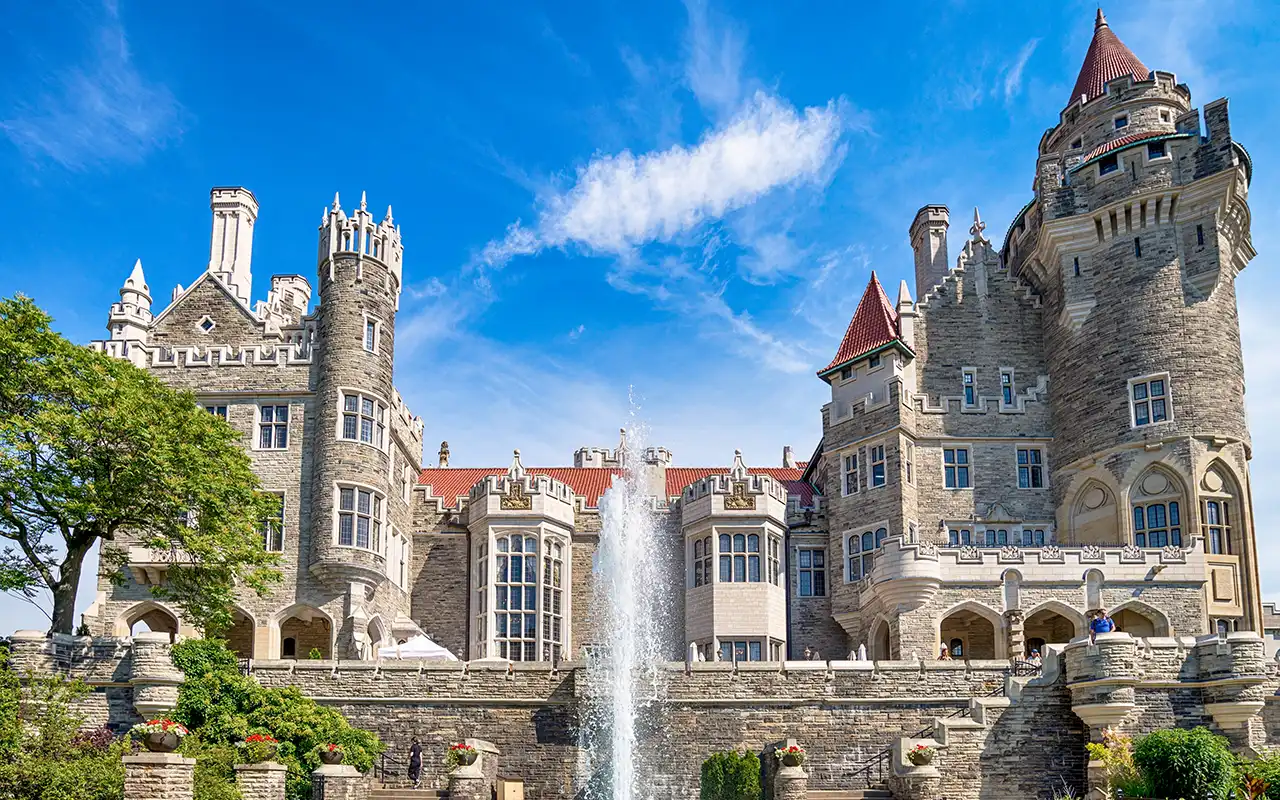Claim to Fame
Casa Loma is Toronto’s only full-sized castle — a majestic Gothic Revival mansion filled with secret passages, towers, and opulent rooms.
📌 Navigating Casa Loma : Answers to Frequently Asked Questions
- Admission Fee: Admission fees apply for entry to Casa Loma, with various ticket options available, including discounts for seniors, youth, and children.
- How Long to Visit: Visitors typically spend 2-3 hours exploring Casa Loma, its suites, secret passages, towers, and 5 acres of estate gardens.
- Washrooms: Accessible washrooms are available throughout Casa Loma.
- Hours of Operation: Casa Loma's opening hours vary, typically from 9:30 am to 5:00 pm, but it's recommended to check the official website for current hours and special events.
- Important Information: Casa Loma, Toronto's Gothic Revival style castle, offers a glimpse into early 20th-century Canadian history and architecture, with seasonal events and escape rooms enhancing the visitor experience.
- Restaurant or Cafe: Casa Loma features a cafe and restaurant, providing dining options for visitors. The gardens also offer a picturesque setting for picnics.
- Gift Shop: A gift shop is available on-site, selling a variety of Casa Loma-themed souvenirs, books, and gifts.
- Handicap Accessible: Casa Loma offers accessible routes and facilities for visitors with disabilities, though some areas may have limitations due to the historic nature of the building.
- Pets: Pets are not allowed inside Casa Loma, with the exception of service animals.
- Guided Tours: Guided tours are available, offering insights into the history, architecture, and notable features of Casa Loma.
- WIFI: WIFI is available for visitors within Casa Loma.
- Picnic Area: Picnic areas are available in the gardens, offering visitors a scenic spot to enjoy their own food.
- Parking: Parking is available on-site at Casa Loma, though spaces can be limited during peak times. Public transportation is a recommended alternative.
- Family Friendly: Casa Loma is family-friendly, with engaging exhibits and activities that appeal to children, including themed events and seasonal decorations.
- Photography: Photography is allowed for personal use, but flash photography and tripods may be restricted, especially during special exhibitions or events.
Photos of Casa Loma
Perched atop a hill overlooking downtown Toronto, Casa Loma is a striking architectural marvel that transports visitors to a world of aristocratic grandeur. Originally built as a private residence, it now stands as one of the city’s most iconic landmarks and a popular filming location for Hollywood blockbusters.
With its soaring turrets, lavish interiors, and sweeping gardens, Casa Loma offers a rich blend of history, design, and drama — perfect for travelers interested in heritage, photography, or unique urban experiences.
What to Expect
A visit to Casa Loma begins with its dramatic façade and landscaped gardens. Inside, explore over 90 rooms decorated in early 20th-century splendor — from wood-paneled libraries and formal dining rooms to servant quarters and a conservatory with stained glass ceilings.
Wander secret passageways, climb the spiral stairs to castle towers with panoramic city views, and explore the underground tunnel leading to the stables and carriage house. Exhibits about the building’s history and its role in Canadian innovation and wartime efforts are also featured throughout.
Background and Cultural Context
Casa Loma was the dream of financier Sir Henry Pellatt, who built the castle between 1911 and 1914 at a cost of over $3 million — a fortune at the time. Inspired by European castles, he spared no expense, hiring the best craftsmen and importing the finest materials.
Unfortunately, Pellatt’s fortune declined shortly after construction, and he lost the mansion to the city due to unpaid taxes. Over the years, Casa Loma served various purposes — from a hotel to a military facility — before being restored and opened to the public as a museum.
Best Time to Visit
Casa Loma is open year-round, but spring and summer offer the added bonus of blooming gardens and outdoor concerts. Arrive early to enjoy a quieter experience and avoid school groups and tour crowds. Evening visits during seasonal events like Legends of Horror or Holiday Lights are also uniquely atmospheric.
How to Get There
Located in midtown Toronto, Casa Loma is easily accessible by subway. Exit at Dupont Station and walk about 5–10 minutes uphill. Paid parking is available on-site for drivers.
Photo Opportunities
- The castle’s towers and turrets from the front courtyard
- Views of the Toronto skyline from the upper towers
- Stained glass windows and chandeliers inside the conservatory
- Formal gardens in bloom during the warmer months
Travel Tips
- Audio guides are included and provide rich historical context — use them!
- There’s a café and gift shop on-site for snacks and souvenirs.
- Plan for about 1.5–2 hours to explore the full grounds at a relaxed pace.
- Wear comfortable shoes — there are many stairs and long hallways.
FAQs
Is Casa Loma wheelchair accessible?
Partially — elevators are available, but some towers and tunnels are not accessible.
Is photography allowed?
Yes — non-flash photography is allowed throughout most of the castle.
Does Casa Loma host events?
Yes — weddings, galas, seasonal experiences, and even escape games are offered regularly.
Final Thoughts
Casa Loma is a rare and regal experience — a slice of European romanticism in the heart of Toronto. From secret stairways to panoramic towers, the castle offers something magical for every visitor. Whether you're a history lover, architecture enthusiast, or casual explorer, Casa Loma is unforgettable.
